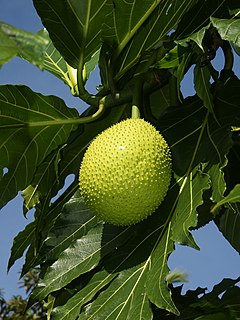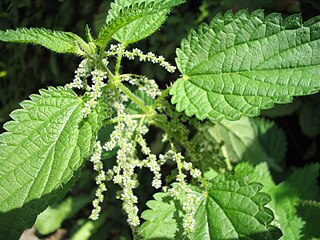
Breadfruit is a species of flowering tree in the mulberry and jackfruit family (Moraceae) believed to be a domesticated descendant of Artocarpus camansi originating in New Guinea, the Maluku Islands, and the Philippines. It was initially spread to Oceania via the Austronesian expansion. It was further spread to other tropical regions of the world during the Colonial Era. British and French navigators introduced a few Polynesian seedless varieties to Caribbean islands during the late 18th century. Today it is grown in some 90 countries throughout South and Southeast Asia, the Pacific Ocean, the Caribbean, Central America and Africa. Its name is derived from the texture of the moderately ripe fruit when cooked, similar to freshly baked bread and having a potato-like flavor.

Ficus is a genus of about 850 species of woody trees, shrubs, vines, epiphytes and hemiepiphytes in the family Moraceae. Collectively known as fig trees or figs, they are native throughout the tropics with a few species extending into the semi-warm temperate zone. The common fig (F. carica) is a temperate species native to southwest Asia and the Mediterranean region, which has been widely cultivated from ancient times for its fruit, also referred to as figs. The fruit of most other species are also edible though they are usually of only local economic importance or eaten as bushfood. However, they are extremely important food resources for wildlife. Figs are also of considerable cultural importance throughout the tropics, both as objects of worship and for their many practical uses.

The Moraceae — often called the mulberry family or fig family — are a family of flowering plants comprising about 38 genera and over 1100 species. Most are widespread in tropical and subtropical regions, less so in temperate climates; however, their distribution is cosmopolitan overall. The only synapomorphy within the Moraceae is presence of laticifers and milky sap in all parenchymatous tissues, but generally useful field characters include two carpels sometimes with one reduced, compound inconspicuous flowers, and compound fruits. The family includes well-known plants such as the fig, banyan, breadfruit, mulberry, and Osage orange. The 'flowers' of Moraceae are often pseudanthia.

The jackfruit, also known as jack tree, is a species of tree in the fig, mulberry, and breadfruit family (Moraceae). Its origin is in the region between the Western Ghats of southern India, all of Sri Lanka and the rainforests of Malaysia.

The Urticaceae are a family, the nettle family, of flowering plants. The family name comes from the genus Urtica. The Urticaceae include a number of well-known and useful plants, including nettles in the genus Urtica, ramie, māmaki, and ajlai.

Artocarpus is a genus of approximately 60 trees and shrubs of Southeast Asian and Pacific origin, belonging to the mulberry family, Moraceae. Most species of Artocarpus are restricted to Southeast Asia; a few cultivated species are more widely distributed, especially A. altilis (breadfruit) and A. heterophyllus (jackfruit), which are cultivated throughout the tropics.

Artocarpus odoratissimus is a species of flowering plant in the Moraceae family. It is a commonly called marang, madang, timadang, terap, tarap, green pedalai, or johey oak. It is native to Borneo, Palawan, and Mindanao Island, and is closely related to the jackfruit, cempedak, and breadfruit trees which all belong to the same genus, Artocarpus.

Maclura is a genus of flowering plants in the mulberry family, Moraceae. It includes the inedible Osage orange, which is used as mosquito repellent and grown throughout the United States as a hedging plant. It is dioecious, with male and female flowers borne on separate plants.
Artocarpus blancoi is a species of plant in the family Moraceae endemic to the Philippines. Its habitat is threatened.
Artocarpus rubrovenia is a species of plant in the family Moraceae. It is endemic to the Philippines. It is threatened by habitat loss. The species was first described in 1904.

Sorocea is a Neotropical genus of woody plants in the family Moraceae. Its distribution ranges from Chiapas to southern Brazil. It is placed within the tribe Moreae, and is closely related to the monotypic Bagassa.

Artocarpeae is a tribe within the plant family Moraceae. It includes 7 to 12 genera and 70 to 87 species including Artocarpus altilis, the breadfruit.

Dorstenia elata is a plant species in the family Moraceae.

Dihydromorin is a flavanonol, a type of flavonoid. It can be found in plants of the family Moraceae including Morus nigra, in Morus alba, Maclura pomifera, in the jackfruit and in Artocarpus dadah.

Artocarpus lacucha, also known as monkey fruit, or Monkey Jack or baṛhal, badahar (Nepali:बडहर) or dewa, Bɔn'Kā̃ʈʰaːl in Rarhi Bangla, Barta (বত্তা) in Chittagonian language of Bangladesh or bohot or Heirikokthong (Meeteilon:ꯍꯩꯔꯤꯀꯣꯛꯊꯣꯡ) and 'Taat' in Thadou-Kuki language of Northeast India, is a tropical evergreen tree species of the family Moraceae. It is distributed throughout the Indian Subcontinent and Southeast Asia. The tree is valued for its wood; its fruit is edible and is believed to have medicinal value. In Northeastern Thailand, the wood is used to make pong lang, a local traditional instrument.

Artocarpus camansi, the breadnut, is a species of medium-sized tree in the family Moraceae. It is native to New Guinea, the Maluku Islands, and the Philippines. It is the wild ancestor of the breadfruit (Artocarpus altilis) and is also sometimes known as the seeded breadfruit, to distinguish it from its mostly seedless descendant. Breadnut fruits are edible when cooked. The large seeds can also be roasted and eaten.
Artocarpus mariannensis, also known as the Marianas breadfruit or the seeded breadfruit, is a species of plant in the mulberry / fig family, Moraceae. It is endemic to the Mariana Islands and Guam. It has been utilised extensively by the Micronesian people, being one of the staple food crops that was introduced to other islands in Micronesia.
Artocarpus rigidus is a tree species in the Moraceae that was described by Blume. A. rigidus is a wild species of the breadfruit/jackfruit genus (Artocarpus) and may be referred to as the 'monkey jack(fruit)'; its Vietnamese name is mít nài.
Artocarpus parvus is a species of plant in the family Moraceae. It is endemic to South-East Asia and Southern China. The species is distinguished by the dark-red and rough bark of the tree. Fruit have yellow-orange and velutinous peel, while the pulp is pink-orange.













